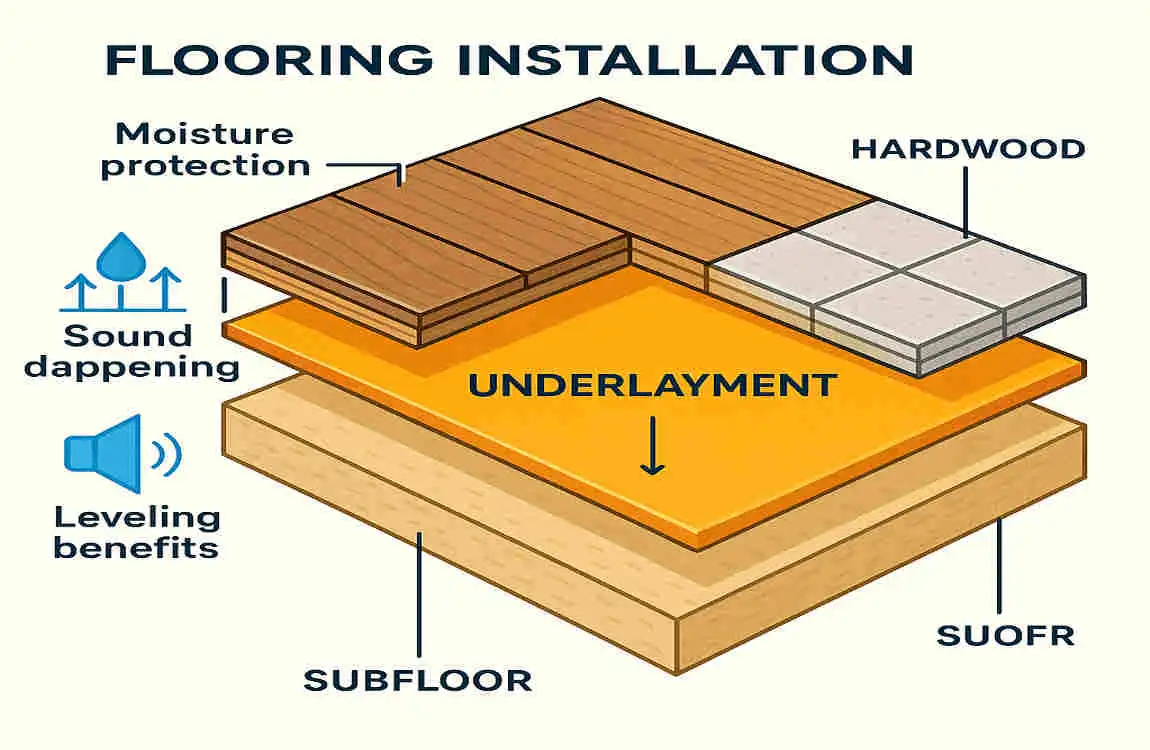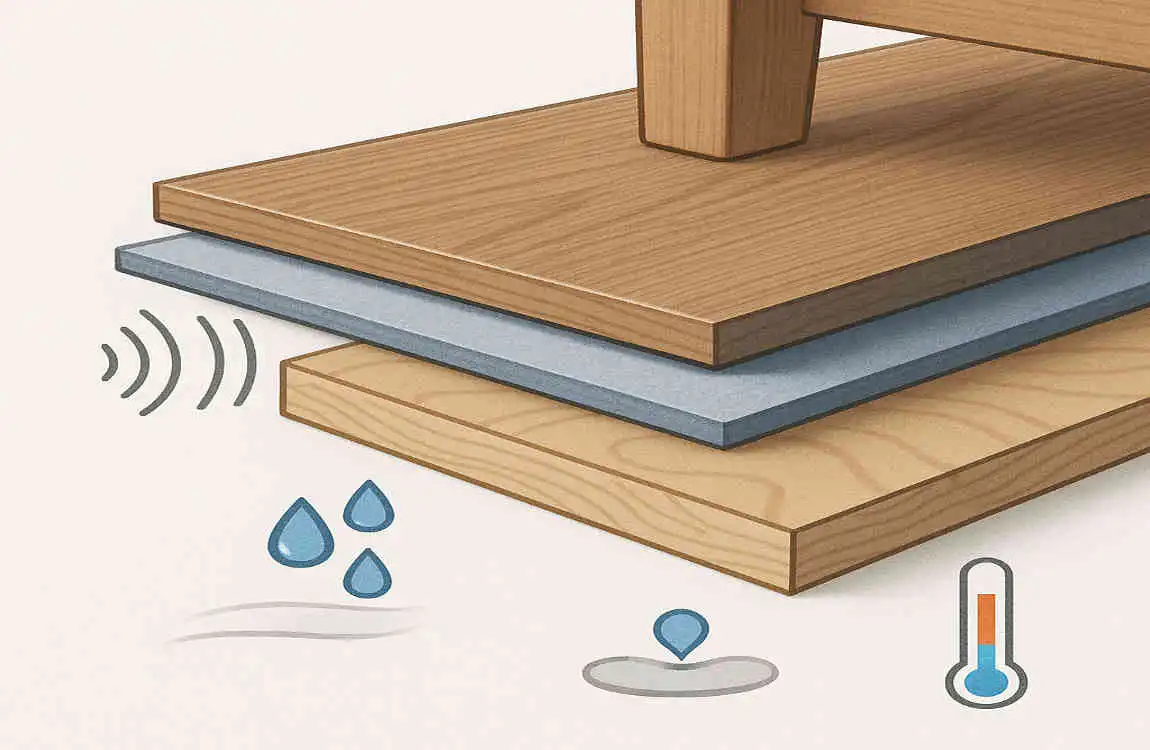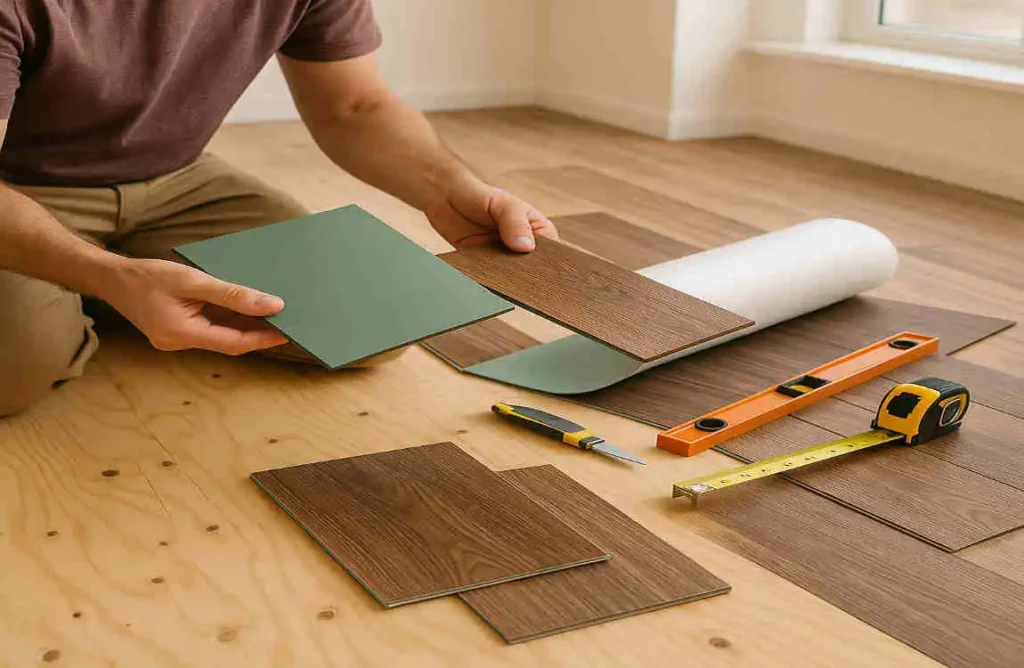Vinyl flooring has become incredibly popular in recent years, and it’s not hard to see why. It’s durable, affordable, and comes in a wide range of styles and colors. If you’re considering installing vinyl flooring in your home, you may wonder about the best approach, especially if you have a plywood subfloor.
What Is Underlayment?

Definition and Purpose of Underlayment
Underlayment is a layer of material that is installed between the subfloor and the flooring itself. Its primary purpose is to provide a smooth, stable surface for the luxury flooring to rest on. Underlayment can help to:
- Level out minor imperfections in the subfloor
- Reduce noise and improve sound insulation
- Provide cushioning and comfort underfoot
- Protect the flooring from moisture damage
Types of Underlayment Materials
There are several types of underlayment materials commonly used with vinyl flooring, each with its own unique properties and benefits. Some of the most popular options include:
- Foam underlayment: This lightweight, flexible material provides good cushioning and sound insulation. It’s often used with luxury vinyl plank (LVP) and luxury vinyl tile (LVT) flooring.
- Cork underlayment: Cork is a natural, eco-friendly material that offers excellent sound absorption and thermal insulation. It’s a great choice for those looking for a more sustainable option.
- Felt underlayment: Felt is a dense, fibrous material that provides good moisture protection and sound insulation. It’s often used with sheet vinyl flooring.
- Rubber underlayment: Rubber is a durable, resilient material that offers excellent sound absorption and cushioning. It’s a popular choice for high-traffic areas.
How Underlayment Affects Flooring Performance
The proper underlayment can have a significant impact on the performance, comfort, and longevity of your vinyl flooring. Here’s how:
- Comfort: Underlayment provides a cushioning layer that makes your floors more comfortable to walk on, especially in areas where you spend a lot of time standing, like the kitchen.
- Sound insulation: Underlayment can help to reduce noise transfer between floors, making your home quieter and more peaceful.
- Longevity: By providing a stable, level surface and protecting against moisture, underlayment can help to extend the life of your vinyl flooring.
- Moisture protection: Some underlayment materials provide an additional layer of protection against moisture, which is especially important in areas prone to spills or high humidity.
Understanding Plywood as a Subfloor
Properties and Types of Plywood
Plywood is a versatile and widely used material for subfloors. It’s made up of multiple layers of wood veneer, which are glued together with the grain of each layer running perpendicular to the adjacent layers. This construction gives plywood its strength and stability.
There are several types of plywood available, each with its own unique properties and uses:
- CDX plywood: This is a standard, cost-effective option for subfloors. It’s made with C-grade veneer on one side and D-grade on the other, with exterior glue for added moisture resistance.
- OSB (Oriented Strand Board): OSB is made from compressed wood strands and is often used as a subfloor material. It’s less expensive than plywood but may not be as strong or stable.
- Marine-grade plywood is a high-quality, moisture-resistant plywood often used in bathrooms and other wet areas.
How Plywood Interacts with Vinyl Flooring
When it comes to installing vinyl flooring on a plywood subfloor, there are a few key factors to consider:
- Moisture: Plywood can be susceptible to moisture damage, which can cause it to swell, warp, or delaminate. This can lead to problems with the vinyl flooring, such as bubbles, cracks, or unevenness.
- Unevenness: Plywood subfloors can sometimes be uneven, which can affect the appearance and performance of the vinyl flooring. Underlayment can level out minor imperfections.
- Stability: Plywood is generally a stable subfloor material; however, it can still expand and contract in response to changes in temperature and humidity. This movement can put stress on the vinyl flooring, potentially causing it to lift or buckle.
Common Concerns with Plywood Subfloors
When working with plywood subfloors, there are a few common concerns to keep in mind:
- Moisture: As mentioned earlier, plywood can be vulnerable to moisture damage. It’s essential to ensure that the subfloor is adequately sealed and protected against humidity before installing vinyl flooring.
- Unevenness: Plywood subfloors can sometimes be uneven, which can affect the appearance and performance of the vinyl flooring. In some cases, it may be necessary to level the subfloor before installation.
- Stability: While plywood is generally a stable subfloor material, it can still be affected by changes in temperature and humidity. This can cause the subfloor to expand and contract, which can put stress on the vinyl flooring.
Do I Need Underlayment for Vinyl Flooring on a Plywood Subfloor?
When Underlayment Is Necessary
Whether or not you need underlayment for vinyl flooring on plywood depends on several factors, including the thickness and type of plywood, the condition of the subfloor, and the moisture levels in your home.
In general, underlayment is recommended in the following situations:
- Thin plywood: If your plywood subfloor is less than 3/4 inch thick, underlayment can help to provide additional stability and support for the vinyl flooring.
- Uneven subfloor: If your plywood subfloor is uneven or has minor imperfections, underlayment can help to level it out and create a smooth surface for the vinyl flooring.
- High moisture levels: If your home has high moisture levels, underlayment can provide an additional layer of protection against moisture damage to the plywood subfloor and the vinyl flooring.
- Noise reduction: If you’re concerned about noise transfer between floors, underlayment can help to reduce sound and improve the overall comfort of your home.
Key Factors Influencing the Need for Underlayment
When deciding whether or not to use underlayment with vinyl flooring on plywood, consider the following key factors:
- Thickness of plywood: Thicker plywood subfloors (3/4 inch or more) are generally more stable and may not require underlayment. Thinner plywood (less than 3/4 inch) may benefit from the added support of underlayment.
- Type of plywood: Some types of plywood, such as marine-grade, are more resistant to moisture and may not require underlayment in certain situations. Other types, like CDX plywood, may benefit from the added protection of underlayment.
- Condition of subfloor: If your plywood subfloor is uneven, damaged, or has minor imperfections, underlayment can help to create a smooth, level surface for the vinyl flooring.
- Moisture levels: High moisture levels in your home can cause problems with plywood subfloors, such as swelling, warping, or delamination. Underlayment can provide an additional layer of protection against moisture damage.
Expert Insights on Installation Best Practices
When it comes to installing vinyl flooring on plywood subfloors, experts recommend the following best practices:
- Prepare the subfloor: Before installing vinyl flooring, ensure the plywood subfloor is clean, dry, and free from debris and old adhesives. If necessary, level the subfloor to ensure a smooth, even surface.
- Choose the proper underlayment: Select an underlayment material that is compatible with your vinyl flooring and meets your specific needs, such as providing moisture protection or sound insulation.
- Install underlayment correctly: Follow the manufacturer’s instructions for installing the underlayment, ensuring that it is adequately secured to the subfloor and that all seams are tightly butted together.
- Lay vinyl flooring carefully: When installing vinyl flooring, ensure it is properly aligned and securely attached to the underlayment. Follow the manufacturer’s instructions for the specific type of vinyl flooring you are using.
Situations Where Underlayment Might Be Optional or Required
In some cases, underlayment may be optional or required for better performance with vinyl flooring on plywood:
- Optional: If your plywood subfloor is thick, stable, and in good condition, and if your home has low moisture levels, you can install vinyl flooring directly on the plywood without underlayment.
- Required: If your plywood subfloor is thin, uneven, or damaged, or if your home has high moisture levels, underlayment is likely necessary to ensure the best performance and longevity of your vinyl flooring.
Benefits of Using Underlayment with Vinyl Flooring on Plywood

Improved Comfort and Sound Insulation
One of the most significant benefits of using underlayment with vinyl flooring on plywood is the improved comfort and sound insulation it provides. Underlayment adds a cushioning layer between the subfloor and the vinyl flooring, making it more comfortable to walk on, especially in areas where you spend a lot of time standing, like the kitchen.
Underlayment also helps to reduce noise transfer between floors, making your home quieter and more peaceful. This can be especially beneficial in multi-story homes or apartments, where noise from upstairs can be a concern.
Protection Against Moisture and Minor Subfloor Imperfections
Another key benefit of underlayment is the protection it provides against moisture and minor subfloor imperfections. Some underlayment materials offer an additional layer of moisture resistance, which can help protect both the plywood subfloor and the vinyl flooring from damage.
Underlayment can also help to level out minor imperfections in the plywood subfloor, creating a smooth, even surface for the vinyl flooring. This can improve the appearance and performance of the flooring, reducing the risk of bubbles, cracks, or unevenness.
Enhanced Durability and Lifespan of Vinyl Flooring
By providing a stable, level surface and protecting against moisture, underlayment can help to extend the life of your vinyl flooring. It can reduce the stress on the flooring caused by movement in the plywood subfloor, thereby preventing issues such as lifting or buckling.
Underlayment can also help to prevent damage from minor subfloor imperfections, which can cause the vinyl flooring to wear unevenly over time. By creating a smooth, even surface, underlayment can help to ensure that your vinyl flooring lasts for many years to come.
Added Thermal Insulation Benefits
In addition to the other benefits, some underlayment materials can also provide added thermal insulation. This can keep your home warmer in the winter and cooler in the summer, potentially reducing your energy costs.
Materials like cork and rubber are particularly effective at providing thermal insulation, making them an excellent choice for those seeking to enhance the energy efficiency of their homes.
How to Choose the Right Underlayment for Vinyl Flooring on Plywood
Characteristics to Look for in an Underlayment Product
When choosing an underlayment product for vinyl flooring on plywood, there are several key characteristics to look for:
- Thickness: The thickness of the underlayment can affect its performance and comfort. Thicker underlayment generally provides better cushioning and sound insulation, but may also increase the floor height.
- Material: Different underlayment materials have different properties and benefits. Consider the specific needs of your home, such as moisture protection or sound insulation, when selecting an underlayment material.
- Moisture resistance: If your home has high moisture levels, look for an underlayment material that offers good moisture resistance, such as rubber or felt.
- Soundproofing: If noise reduction is a priority, choose an underlayment material with good soundproofing properties, such as cork or rubber.
Recommended Types of Underlayment
Some of the most commonly recommended types of underlayment for vinyl flooring on plywood include:
- Foam underlayment: This lightweight, flexible material provides good cushioning and sound insulation. It’s often used with luxury vinyl plank (LVP) and luxury vinyl tile (LVT) flooring.
- Cork underlayment: Cork is a natural, eco-friendly material that offers excellent sound absorption and thermal insulation. It’s a great choice for those looking for a more sustainable option.
- Felt underlayment: Felt is a dense, fibrous material that provides good moisture protection and sound insulation. It’s often used with sheet vinyl flooring.
- Rubber underlayment: Rubber is a durable, resilient material that offers excellent sound absorption and cushioning. It’s a popular choice for high-traffic areas.
- Specialty products: A variety of specialty underlayment products are also available, designed to meet specific needs such as moisture protection or soundproofing. These can be a good choice for homes with unique requirements.
Compatibility Considerations with Different Vinyl Flooring Types
When choosing an underlayment product, it’s essential to consider the specific type of vinyl flooring you’ll be installing. Here are some compatibility considerations for different types of vinyl flooring:
- Sheet vinyl: Sheet vinyl is often installed with a full-spread adhesive, so it’s essential to choose an underlayment that is compatible with this type of adhesive. Felt and foam underlayment are commonly used with sheet vinyl.
- Luxury vinyl plank (LVP): LVP is typically installed as a floating floor, meaning it’s not glued down to the subfloor. Foam and cork underlayment are popular choices for LVP, as they provide good cushioning and sound insulation.
- Luxury vinyl tile (LVT): Like LVP, LVT is often installed as a floating floor. Foam and cork underlayment are commonly used with LVT, but rubber underlayment can also be a good choice for high-traffic areas.
Step-by-Step Guide: Installing Underlayment and Vinyl Flooring on Plywood
Preparing Plywood Subfloor
Before installing underlayment and vinyl flooring, it’s essential to properly prepare the plywood subfloor. Here’s how:
- Clean the subfloor: Sweep or vacuum the plywood subfloor to remove any dirt, dust, or debris. Make sure the surface is clean and dry before proceeding.
- Level the subfloor: If the plywood subfloor is uneven, use a self-leveling compound to create a smooth, level surface. Follow the manufacturer’s instructions for mixing and applying the compound.
- Moisture test: Use a moisture meter to check the moisture levels in the plywood subfloor. If the moisture content is above the recommended level for your vinyl flooring, you may need to take steps to reduce the moisture before proceeding.
Installing the Underlayment
Once the plywood subfloor is prepared, you can begin installing the underlayment. Here’s how:
- Choose the proper underlayment: Select an underlayment material that is compatible with your vinyl flooring and meets your specific needs, such as providing moisture protection or sound insulation.
- Roll out the underlayment: Starting at one corner of the room, roll out the underlayment across the plywood subfloor. Ensure the underlayment is oriented in the correct direction, as specified by the manufacturer’s instructions.
- Cut the underlayment: Use a utility knife to cut the underlayment to fit the room’s dimensions. Leave a small gap (about 1/8 inch) around the perimeter of the room to allow for expansion.
- Secure the underlayment: Depending on the type of underlayment, you may need to secure it to the plywood subfloor using adhesive, nails, or staples. Follow the manufacturer’s instructions for the specific underlayment product you’re using.
- Seam the underlayment: If you need to use multiple pieces of underlayment to cover the entire floor, ensure that you tightly butt the seams together to prevent gaps. Use seam tape or adhesive to secure the seams and prevent them from separating over time.
Laying Vinyl Flooring Over the Underlayment
Once the underlayment is installed, you can begin laying the vinyl flooring. Here’s how:
- Acclimate the flooring: Before installing the vinyl flooring, ensure it is acclimated to the room’s temperature and humidity for at least 48 hours. This will help to prevent issues with expansion or contraction after installation.
- Start in a corner: Begin laying the vinyl flooring in one corner of the room, working your way across the floor from left to right. Make sure the first row is straight and properly aligned with the walls.
- Cut the flooring: Use a utility knife to cut the vinyl flooring to fit the room’s dimensions. Leave a small gap (about 1/8 inch) around the perimeter of the room to allow for expansion.
- Secure the flooring: Depending on the type of vinyl flooring, you may need to secure it to the underlayment using adhesive or a floating floor system. Follow the manufacturer’s instructions for the specific vinyl flooring product you’re using.
- Finish the installation: Once all the vinyl flooring is laid, use a roller to press it firmly into place, ensuring a secure bond with the underlayment. Install any necessary trim or molding to finish the edges of the floor.
Common Mistakes to Avoid During Installation
To ensure a successful installation, be sure to avoid these common mistakes:
- Skipping the subfloor preparation: Failing to properly clean, level, and test the moisture levels of the plywood subfloor can lead to problems with the vinyl flooring, such as bubbles, cracks, or unevenness.
- Using the wrong underlayment: Selecting an underlayment that is incompatible with your vinyl flooring or unsuitable for your specific needs can compromise the floor’s performance and longevity.
- Improperly installing the underlayment: Failing to secure the underlayment properly or leaving gaps between the seams can cause the vinyl flooring to shift or buckle over time.
- Rushing the installation: Trying to install the vinyl flooring too quickly can lead to mistakes, such as misaligned planks or tiles, uneven seams, or inadequate adhesion. Take your time and follow the manufacturer’s instructions carefully.
